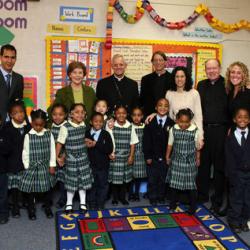![https://commons.wikimedia.org/wiki/File%3ASan_Domenico_School_-_July_2016.jpg; By Mr. Granger (Own work) [CC0], via Wikimedia Commons](https://wp-media.patheos.com/blogs/sites/533/2017/08/San_Domenico_School_-_July_2016.jpg)
In the (other) news on Friday, a Catholic school in Marin County, California is discarding its religious statuary, keeping only 18 out of 180. Here’s Legal Insurrection on the topic, and here’s the local newspaper:
Removal of a number of statues and other smaller Catholic icons from the campus of San Domenico School in San Anselmo has raised concerns among some parents.
In an email to the school’s board of directors, Dominican Sisters of San Rafael and the head of school, Shannon Fitzpatrick objected to the removal of the statues and other steps the school has taken in an effort to make the school more inclusive.
“Articulating an inclusive foundation appears to mean letting go of San Domenico’s 167-year tradition as a Dominican Catholic school and being both afraid and ashamed to celebrate one’s heritage and beliefs,” wrote Fitzpatrick, whose 8-year-old son attends the school.
She added, “In our time here, the word ‘Catholic’ has been removed from the mission statement, sacraments were removed from the curriculum, the lower school curriculum was changed to world religions, the logo and colors were changed to be ‘less Catholic,’ and the uniform was changed to be less Catholic.”
But here’s the larger issue:
This is not a Catholic school in the way that we think of it at all.
The tuition at San Domenico? It starts at $30,000, for the younger kids, and increases to $43,000 for the high schoolers, or $58,000 for the boarding school.
Is this a standard tuition rate for a high-end school?
The article says,
schools operated by the Catholic Church, such as St. Isabella, Marin Catholic and St. Anselm, tend to have larger class sizes and lower tuition costs.
And indeed, the other Catholic schools mentioned have more “normal” levels of tuition: Marin Catholic High School ($20,000), St. Isabella (K-8) ($10,000), St. Anselm ($9,000). If San Domenico is cheaper than the non-Catholic private schools, well, I can’t even begin to imagine what those schools cost, since San Domenico is already substantially more expensive than the private school I thought of because it’s near my childhood home, but right in line with Lake Forest Academy in suburban Chicago.
And, for comparison, a “regular” parochial school even in wealthy Lake Forest, turns out to have tuition that’s pretty much in line with a “normal” Catholic school even in a less-tony suburb, that is, about $6,000 for one child, proportionately less per child for more children. Rates are similar at Sacred Heart in Winnetka, a similarly-wealthy school.
[Update: I reread the original article. I had first understood this as saying that San Domenico, as a Catholic school, was lower in tuition than other “independent” schools. I think instead they’re saying that San Domenico is not “operated by the Catholic Church” and therefore has smaller class sizes and larger tuition costs than “true” Catholic schools.]
Another piece of context:
Of the 660 students who attend the K-12 school, 121 are boarding students and 98 of these are international students from British Columbia, Beijing, Shanghai, Hong Kong, Mexico, Korea, Thailand and Vietnam. The students attending San Domenico come from a variety of religious backgrounds besides Christianity: Judaism, Buddhism, Hinduism and Islam. . . .
[Head of School Cecily] Stock said, “Over the last few years we’ve had fewer Catholic students as part of the community and a larger number of students of various faith traditions. Right now about 80 percent of our families do not identify as Catholic.”
The school also does not offer any specifically Catholic religious education, and its “religious studies” classes do not teach Catholicism as Truth but instead take a comparative religion approach, and seniors can choose among History of Catholicism, Zen Buddhism, or social justice electives. Catholic religious education used to be an after-school activity, but this was then tossed entirely with the expectation that children in Catholic families would receive this at their parishes just like other parishioners. About the only vestige of Catholicism is that their school menu offers fish on Fridays.
So there seems to be very little left of the school’s “Dominican heritage.” Which means it’s not about removing statuary, but rather: why are the Domincans still actively “sponsoring” the school at all?
According to the school’s own timeline, they were founded in 1850. This seems to have originally been a part of the same institution as eventually became Dominican University of California, whose own online history says that the original motivation was to educate the daughters of the 49ers. When this evolved into educating the upper class, I can’t tell. And I have the impression that sisters operating boarding schools for the wealthy isn’t all that unusual, and was perhaps justified in the same way as hospitals: revenue from the paying customers supports charity for the poor.
But is that what’s happening here? Do the Dominican sisters, who continue to be represented on the Board of Trustees (three spots), gain more from their continued affiliation than it costs them — in revenue for genuinely charitable endeavors or for support for retired sisters, whether directly, or indirectly through donations from parents and alumni? Do they justify their continued role because they attempt to teach these children about social justice and feel this would be lost in their absence? Because there are financial aid offerings for a limited number of families?
Somewhere along the way, after all, a school that was originally meant for the poor became a school for the insanely wealthy among us. I suppose I could see some reasonable justification for calling the school “Catholic” if it includes Catholic doctrinal instruction, Catholic mass, or other active elements of practicing Catholicism. But absent that, it seems almost an offense to the name “Catholic” to use that label for such a place, providing a educational experience of such immense privilege, solely because it teaches its children environmentalism and service projects — which I’d wager are likely not distinctive but no different than any similar schools.
ADDED: I did a further read-through of their website, and I’ll have to ask for readers’ thoughts here, as it’s not even clear that they hold themselves out as a Catholic school any longer. They seem to see “Dominican heritage” as something that’s not particularly connected to being Catholic, which is all the more reason for the Dominicans to sever ties.
Image: https://commons.wikimedia.org/wiki/File%3ASan_Domenico_School_-_July_2016.jpg; By Mr. Granger (Own work) [CC0], via Wikimedia Commons













